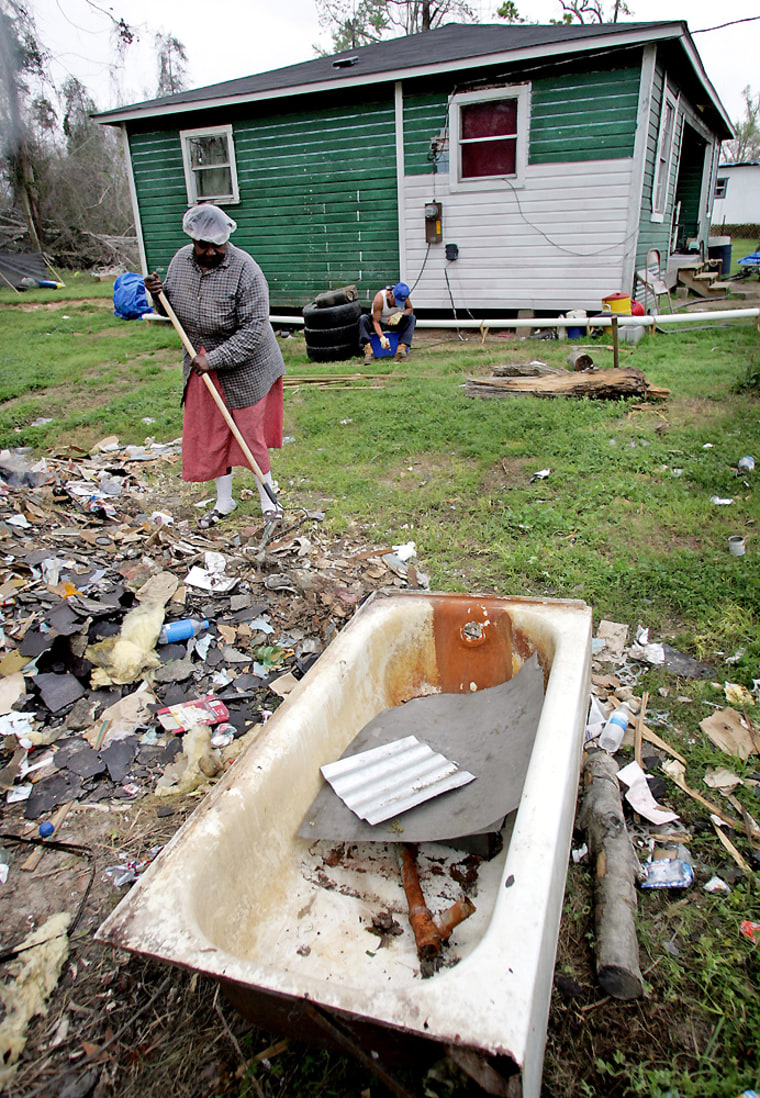Nestled among some of the nation's largest petrochemical plants and gas refineries sits this tiny blue-collar community that thinks of itself as the forgotten victim of a forgotten storm.
Almost half of the 253 homes are gone; the other half are heavily damaged. The post office lies in splinters, and mounds of debris still dot the town. Small travel trailers cover the landscape, making this look like a campground instead of the permanent home to 750 residents, many of them roughnecks on offshore oil rigs or shrimpers on the Gulf Coast.
The Sabine Pass School reopened its doors 5 1/2 months ago, and ABC's "Extreme Makeover" crew rehabbed the local firehouse and the school auditorium. But the only grocery store, the only convenience store, the only gas station and the only hardware store remain closed. Just eight houses are occupied.
The good news: One of the two diners in town finally reopened last week.
"Rita Who?" reads the marquee outside Skeeter's Bar and Grill. Rita who, indeed.
‘Well, we believe we're significant’
This was ground zero for Hurricane Rita when it came ashore on Sept. 24 as a Category 3 storm with winds of almost 120 miles per hour. At the time, the area was described in some national media reports as "sparsely populated and insignificant." It wasn't Houston, the country's fourth-largest city, just west of here, and it wasn't New Orleans, the city to the east completely devastated nearly four weeks earlier when the levees broke after Hurricane Katrina.
"Well, we believe we're significant," said Scottie Berg, the local school secretary, who has been living since Dec. 5 with her two children in a 24-by-14-foot trailer issued by the Federal Emergency Management Agency.
She and her neighbors in southeast Texas believe that they have been neglected by the Bush administration and by Congress, which have doled out billions of dollars in recovery aid largely to Louisiana and Mississippi. They also believe they have been overlooked by the country at large.
Many of the regional officials say that their resources were already depleted when Hurricane Rita hit, because the area had housed and cared for more than 30,000 Katrina evacuees.
"I'm hiring a consultant to come in and help us manage people's lives after so much stress and change, and I told him it's Hurricane Rita," said Verna Rutherford, president of the Greater Port Arthur Chamber of Commerce.
"He's still sending me e-mails saying it's so unfortunate what happened about Hurricane Katrina."
Seeking their fair share
With Congress once again negotiating a supplemental appropriation that could send $11 billion to $20 billion more to the storm-damaged Gulf Coast region, southeast Texas officials and residents are working overtime to get a fair share of the aid. Texas officials, who received $74.5 million, or less than 1 percent, of the previous $11.5 billion allocated to the Department of Housing and Urban Development for hurricane housing recovery, are hoping to get $600 million to $1 billion this round.
More than 75,000 destroyed or damaged households and thousands of ruined businesses are depending on it, officials in southeast Texas say, as are several petrochemical companies and gas refineries that -- before Rita -- had planned to invest $5.6 billion in new or expanded facilities in a crucial corner of the U.S. petroleum industry. The Golden Triangle, as this area along the Texas-Louisiana border is known, includes Beaumont, Port Arthur, Orange and tiny Sabine Pass, and it produces an estimated 20 percent of the nation's jet fuel and 11 percent of its gasoline.
"The problem is we do not have housing . . . and no housing means no workers," said Mark Viator, chairman of the Southeast Texas Recovery Coalition. "No workers means we may not be able to do these projects."
No large infusion of federal housing dollars also means that residents who were underinsured or uninsured -- many of them elderly or low-income -- may not be able to rebuild. For Berg, who may be able to get a mortgage to buy her own trailer when FEMA recalls its "temporary housing" next spring, staying in Sabine Pass may be impossible. Post-Rita regulations require Berg to locate her trailer 12 feet above sea level. That means she'll have to install pylons or build up the foundation on her property -- at an estimated cost of $20,000.
"Where am I going to get that money?" Berg asked.
In nearby Port Arthur, Romona Kennerson fought with her insurance company until she got a $6,300 settlement on the totally damaged three-bedroom house she had inherited from her parents. That sum paid to gut the house, but all she has now is a skeleton of a structure, with patches of hairy black mold still dangling from some air-conditioning ducts. Contractors told her it would cost about $53,000 to rehabilitate the house.
"I have applied for every assistance possible because what did I have to lose?" said Kennerson, who is renting a small house for herself and her 15-year-old son. She had to move her 30-year-old mentally retarded son, who lived with her before Rita, into a group home until she can get the family back into the house.
She is working with the South East Texas Regional Planning Commission, which is administering a small emergency hurricane relief fund Gov. Rick Perry (R) created to take care of the "unmet needs" of Rita victims who are elderly, disabled or low-income. But given the overwhelming needs, the grants will be only a few thousand dollars apiece and cover perhaps 350 households at most, officials said.
"We were not like New Orleans and Mississippi, but we got the butt end of this storm," Kennerson said. "This has been my home, the boys' home for two years . . . and in one day, everything is lost."
